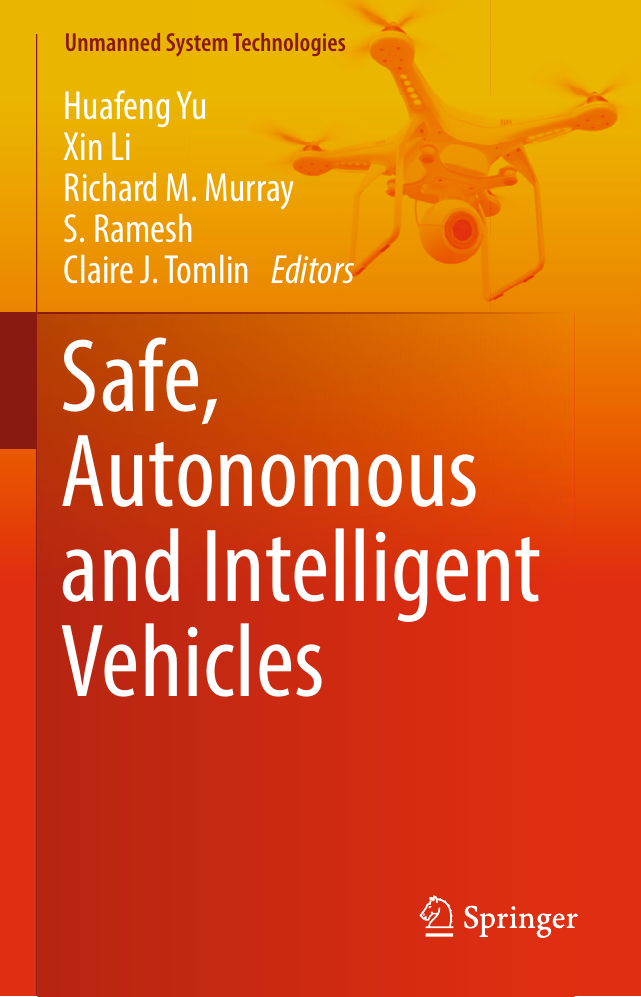Preface
Contents
About the Editors
1 Introduction
2 Efficient Statistical Validation of Autonomous Driving Systems
2.1 Introduction
2.2 Background
2.2.1 Image Sensing
2.2.2 Image Processing
2.2.3 Visual Perception
2.3 Test Data Generation
2.3.1 Temperature Variation
2.3.2 Circuit Aging
2.3.3 Corner Case Generation
2.3.4 Numerical Experiments
2.3.4.1 Experimental Setup
2.3.4.2 Temperature Variation
2.3.4.3 Circuit Aging
2.4 Subset Simulation
2.4.1 Mathematical Formulation
2.4.2 Random Sampling
2.4.3 Summary
2.4.4 Numerical Experiments
2.4.4.1 Experimental Setup
2.4.4.2 Experimental Results
2.5 Conclusions
References
3 Cyberattack-Resilient Hybrid Controller Design with Application to UAS
3.1 Introduction
3.2 Problem Formulation
3.2.1 System and Cyberattack Models
3.2.2 Cyberattack Mitigation Problem
3.3 Hybrid Controller Design
3.4 Analytical Performance Verification
3.5 Extension to Infinite Time Horizon: Receding Horizon Controller
3.6 Illustrative Example
3.6.1 H2 Optimal Controller
3.6.2 H∞ Optimal Controller
3.6.3 UAS Model
3.6.4 Simulation Results
3.7 Conclusions
References
4 Control and Safety of Autonomous Vehicles with Learning-Enabled Components
4.1 Hamilton–Jacobi Reachability
4.1.1 Backward Reachable Set (BRS)
4.1.2 Application: Provably Safe Multi-Vehicle Trajectory Planning
4.1.3 Limitations of HJ Reachability
4.2 Learning-Based Model Refinement
4.2.1 Function Approximator-Based Model Learning
4.2.2 Goal-Driven Model Learning
4.3 Safety Analysis of Learned Models
4.3.1 Safety During Model Learning
4.3.2 Model Validation Before Deployment
4.4 Learning in Partially Observable environments
References
5 Adaptive Stress Testing of Safety-Critical Systems
5.1 Introduction
5.2 Related Work
5.3 Background
5.3.1 Definitions
5.3.2 Sequential Decision Process
5.3.3 Monte Carlo Tree Search
5.4 Adaptive Stress Testing
5.4.1 Full Observability
5.4.2 Partial Observability
5.5 Aircraft Collision Avoidance Application
5.5.1 Experimental Setup
5.5.2 Results
5.5.3 Performance Comparison
5.6 Conclusion
References
6 Provably-Correct Compositional Synthesis of VehicleSafety Systems
6.1 Introduction
6.2 Autonomous Driving Functions
6.2.1 Adaptive Cruise Control
6.2.2 Lane Keeping
6.2.3 Challenges in Composition
6.3 Composition of Invariant Sets Via Contracts
6.3.1 Contract Realizability Problem
6.3.2 Contract Refinement Heuristic
6.4 Contract Realizability Via Polyhedral Controlled-Invariant Sets
6.4.1 Computation of Polyhedral Controlled-Invariant Sets
6.4.2 Over-Approximation of Nonlinear Parametrizations
6.4.3 Removal of Nonlinearities via Convexification
6.4.3.1 Convex-Hull Computation With Monotone Functions
6.4.3.2 Convex-Hull Computation With Convex Projections
6.5 Design Flow for the Case Study
6.5.1 Constraints
6.5.2 Contracts
6.5.3 Realizability of LK Contract
6.5.4 Realizability of ACC Contract
6.5.5 Low-Fidelity Simulation Results
6.5.6 CarSim Simulation Results
6.6 Implementation in Mcity
6.7 Conclusions
References
7 Reachable Set Estimation and Verification for Neural Network Models of Nonlinear Dynamic Systems
7.1 Introduction
7.2 Neural Network Models of Nonlinear Dynamic Systems
7.3 Problem Formulation
7.4 Reachable Set Estimation for MLPs
7.5 Reachable Set Estimation for NARMA Models
7.6 Magnetic Levitation Systems (Maglev)
7.6.1 Brief Introduction
7.6.2 Neural Network Model
7.6.3 Reachable Set Estimation
7.7 Conclusions
References
8 Adaptation of Human Licensing Examinations to the Certification of Autonomous Systems
8.1 Introduction
8.1.1 Driving Licensing Exams
8.1.2 Aviation Licensing Exams
8.2 SRKE Taxonomy
8.3 Implications of Human Licensing on Autonomous Vehicle Certification
8.3.1 Vision Tests for AVs?
8.3.2 Knowledge Tests and Checkrides for AVs?
8.3.3 Graduated Licensing
8.3.4 Certifying Machine Learning Algorithms Is Unprecedented
8.4 Conclusion
References
9 Model-Based Software Synthesis for Safety-Critical Cyber-Physical Systems
9.1 Software Challenges in Safety-Critical Cyber-Physical Systems
9.2 Model-Based Software Synthesis Flow
9.3 Holistic Timing-Driven Synthesis
9.4 Multi-Objective Optimization
9.4.1 Fault-Tolerance
9.4.2 Security
9.5 Cross-Layer Codesign
9.6 Conclusion
References
10 Compositional Verification for Autonomous Systems with Deep Learning Components
10.1 Introduction
10.2 Compositional Verification
10.3 Analysis for Deep Neural Network Components
10.3.1 ACAS Xu Case Study
10.4 Example
10.4.1 Run-Time Monitoring and Control
10.5 Conclusion
References
Index
















 2023年江西萍乡中考道德与法治真题及答案.doc
2023年江西萍乡中考道德与法治真题及答案.doc 2012年重庆南川中考生物真题及答案.doc
2012年重庆南川中考生物真题及答案.doc 2013年江西师范大学地理学综合及文艺理论基础考研真题.doc
2013年江西师范大学地理学综合及文艺理论基础考研真题.doc 2020年四川甘孜小升初语文真题及答案I卷.doc
2020年四川甘孜小升初语文真题及答案I卷.doc 2020年注册岩土工程师专业基础考试真题及答案.doc
2020年注册岩土工程师专业基础考试真题及答案.doc 2023-2024学年福建省厦门市九年级上学期数学月考试题及答案.doc
2023-2024学年福建省厦门市九年级上学期数学月考试题及答案.doc 2021-2022学年辽宁省沈阳市大东区九年级上学期语文期末试题及答案.doc
2021-2022学年辽宁省沈阳市大东区九年级上学期语文期末试题及答案.doc 2022-2023学年北京东城区初三第一学期物理期末试卷及答案.doc
2022-2023学年北京东城区初三第一学期物理期末试卷及答案.doc 2018上半年江西教师资格初中地理学科知识与教学能力真题及答案.doc
2018上半年江西教师资格初中地理学科知识与教学能力真题及答案.doc 2012年河北国家公务员申论考试真题及答案-省级.doc
2012年河北国家公务员申论考试真题及答案-省级.doc 2020-2021学年江苏省扬州市江都区邵樊片九年级上学期数学第一次质量检测试题及答案.doc
2020-2021学年江苏省扬州市江都区邵樊片九年级上学期数学第一次质量检测试题及答案.doc 2022下半年黑龙江教师资格证中学综合素质真题及答案.doc
2022下半年黑龙江教师资格证中学综合素质真题及答案.doc